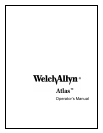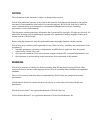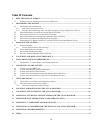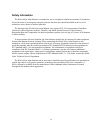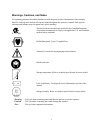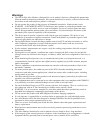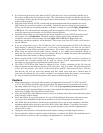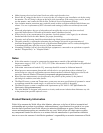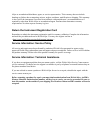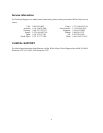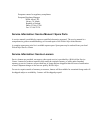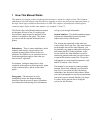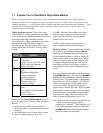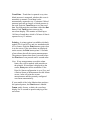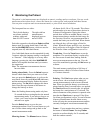vii
• If an electrosurgical unit is used, place the ECG cable and wires as far as possible from the site of
the surgery and from the electrosurgical cables. This will minimize interference and the risk of burns
to the patient. Ensure that the electrosurgical return cable (neutral) is well attached and making good
contact with the patient.
• End tidal carbon dioxide (ETCO
2
) and breath rate measurement and alarm capability are active
ONLY when the second trace option is set to CO
2
. Should the operator change from viewing the
ETCO
2
and breath rate waveforms and data to another second trace selection (SpO
2
, Respiration
or ECG) the CO
2
and breath rate monitoring and alarm capability will be disabled. This occurs
even if the watertrap and cannula are still inserted into the Monitor.
• Impedance Respiration rate measurement and alarm capability are active ONLY when the second
trace option is set to Respiration. Should the operator change from viewing the Respiration
waveforms and breath rate to another selection (SpO
2
, CO
2
or ECG) the Respiration rate
monitoring and alarm capability will be disabled. This occurs even if the ECG cable is still inserted
into the Monitor.
• If you are using battery power, the AC indicator (AC~) on the front panel will NOT be lit. When the
Atlas monitor is running on battery power, it will warn you when there is less than 10, less than 5,
and less than 1 minute of life remaining in the battery. See section 3.4 for battery alarm information.
• When using the motion tolerant pulse oximetry channel, a very sudden and substantial change in
pulse rate can result in erroneous pulse rate readings. Be sure to validate the patient data and patient
condition before intervention or change in patient care.
• When using the 6200-12 ECG Wrist-Klip, although a normal Lead I QRS waveform is produced on
the monitor, this waveform should not be used for serious clinical interpretation because the
electrodes are not properly triangulated around the patient’s heart.
• The 6200-12 ECG Wrist-Klip cannot be adjusted in size. Proper orientation of the clip with the
monitor depends on adjusting the position of the clip until a snug fit is found. The preferred position
of the clip is the patient’s wrist but it can be moved up the patient’s arm toward the torso. You may
find that the clip will not work with patients that have small wrists and arms. Caution must be
exercised when placing the clip so that circulation is not impeded along the patient’s wrist and arm.
If a snug fit cannot be found on the patient, other means of monitoring must be used.
Cautions
• When transporting or storing the Atlas monitor at temperatures between 40
°
C (104
°
F) and 50
°
C
(122
°
F), the following procedure must be performed. The monitor must be returned to the normal
operating temperature range of 10
°
C (50
°
F) - 40
°
C (104
°
F) for a period of at least two hours. If
patient monitoring is performed before two hours has elapsed, the displayed and printed ETCO2
values may be higher than the patient's actual values.
• Place the Welch Allyn Atlas Monitor and accessories in locations where they cannot harm the patient
if they fall off a shelf or mount.
• Never place fluids on top of this monitor. In case of fluid spilling on the monitor, disconnect power
cord, wipe clean immediately and have the monitor serviced to ensure that no hazard exists.
• This Welch Allyn Atlas Monitor should not be stacked directly on top of other equipment, and other
equipment should not be stacked on top of this Welch Allyn Atlas Monitor. If stacking is necessary,
observe the Welch Allyn Atlas Monitor to verify normal operation in the stacked configuration in
which it will be used.
• Unplug the external power cord from the monitor before cleaning or disinfecting the monitor.
• Do not autoclave, subject to ethylene oxide sterilization, or immerse the Welch Allyn Atlas Monitor in
liquid. Sterilize accessories only according to the manufacturer’s instructions.



